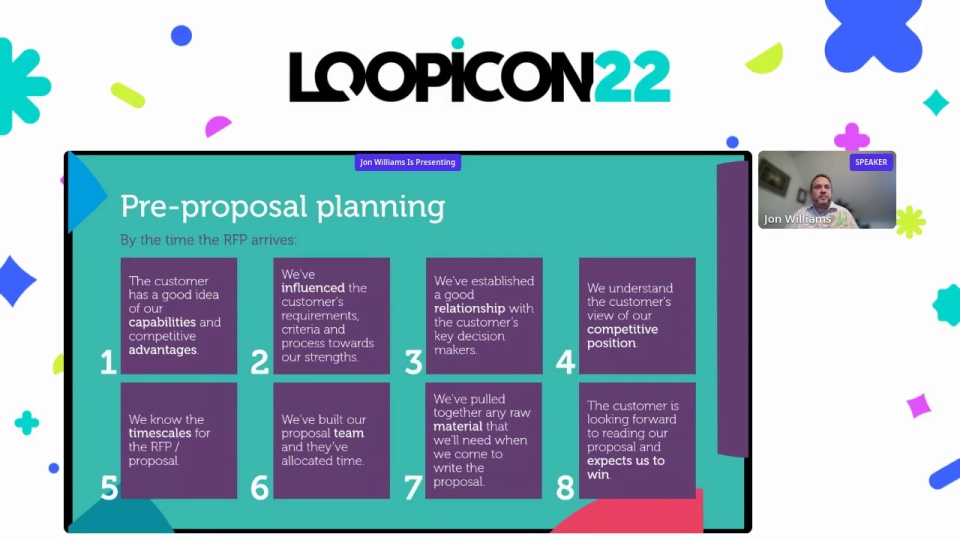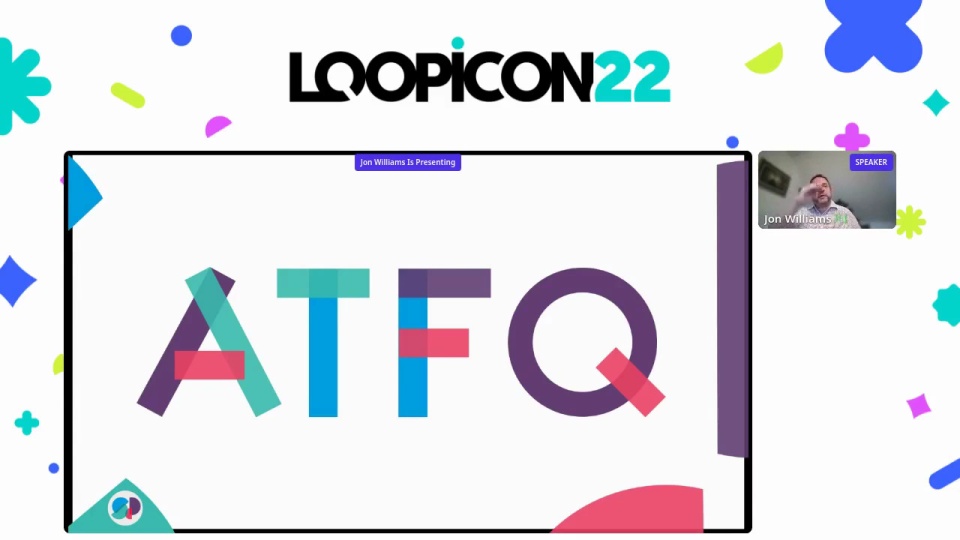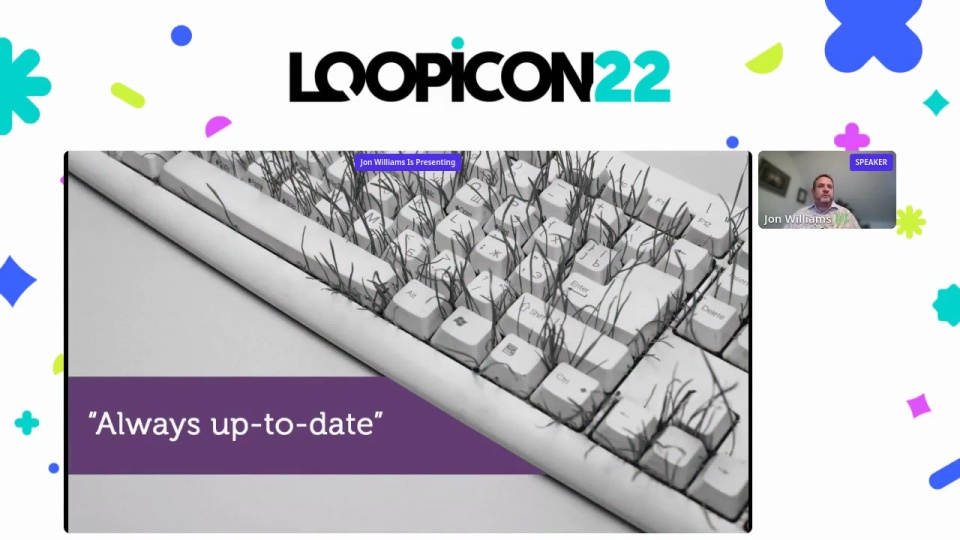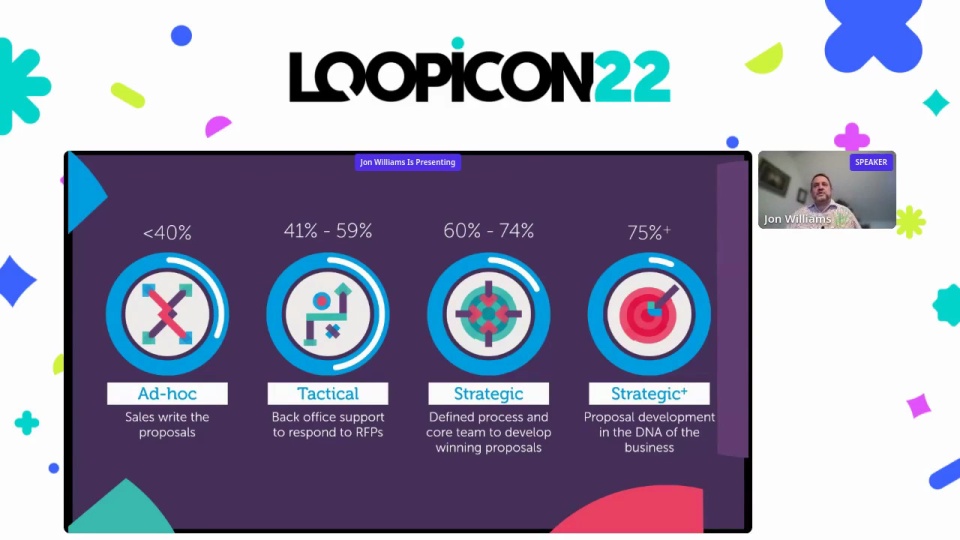Raise your hand if you’ve ever received an RFP rejection letter after spending 40+ grueling hours addressing everything on the client’s wishlist. Even after following all of their specific rules (down to a tee) in the spirit of “all is fair in RFPs.” 🙋
It’s okay—you can’t win them all. In fact, the average RFP win rate is 44%, which means most teams can relate to the feeling of losing the majority of the time. But there’s hope if you want to increase your win rate.
According to Jon Williams, Managing Director of Strategic Proposals, you can win the bid more often (and more easily) by focusing on four strategic areas:
Keep reading to learn Jon’s expert advice from 20+ years of working on bids and leading an award-winning team of 30 brilliant proposal managers, writers, and designers. Psst … he also has a guilty secret of starting his career in procurement, so he knows what it takes to win—and what holds most teams back.
“Writing good proposals helps win business, generate more revenue, and create jobs. That’s why we should be so proud of what we do—and what we deliver for our organizations.”

Winning Process: Create a Blueprint for Responding to RFPs
Without a blueprint for responding to requests for proposals (RFPs), you put undue pressure on your team to reinvent the wheel every time. And the results can be detrimental, often leading to rushed and unconvincing proposals. Instead, a defined RFP response process ensures you chase the right business, tell a compelling story, submit the bid on time, and learn what wins and what doesn’t.
While Jon says there are ten stages in total, he focuses on three as a great place to start for optimizing the RFP process.
1. Follow a Bid/No-Bid Process
“If you have a bid/no-bid process, you’ll never find yourself chasing a deal unless you’re absolutely confident you’re going to win it.” says Jon. The good news is that 80% of RFP teams follow a qualification process of some kind, but strategically selecting which RFPs to focus on and ignore is still a top challenge.
So, how do you know if your RFP evaluation criteria is strong enough? Jon says you should be able to answer four questions before deciding whether to pursue a bid:
- Is it real? Is there a genuine piece of business to be won? If they’ve got an existing supplier, can we clearly articulate their points of dissatisfaction? Or is this just an exercise to keep the incumbent on their toes?
- Do we want it? Is this business something we can make money from? Is this buyer a target client for us?
- Can we win it? What is our relationship like with the key decision-makers in their organization? Have we got a great solution? Can we tell stories of how we delivered this solution successfully to other clients in the past?
- Can we do it? Have we got the resources, capacity, senior level support, and cash flow to meet their expectations?
If the answer to any of these questions is no, you should think twice about bidding. “The mindset you need is: every deal is qualified out until it’s qualified in,” he says. “Your default setting should be no bid unless you have the right business case.”
The invitation to tender has landed and the gate is shut. Your default setting should be ‘No Bid’ unless you can build the business case to do so. Only then can you open the gate and keep going.

2. Build Momentum Before the Bid Arrives
A good proposal team makes a plan when an RFP arrives. A great proposal team makes a plan before the RFP arrives. In this stage, Jon says your chances of winning will be much higher if you can hit these pre-proposal targets:
✓ The customer has a good idea of your capabilities and competitive advantages.
✓ You’ve influenced the customer’s requirements, criteria, and process toward your strengths.
✓ You’ve established a good relationship with the customer’s key decision-makers.
✓ You understand the customer’s view of your competitive position.
✓ You know the timescales for the RFP/proposal.
✓ You’ve built your proposal team, and they’ve allocated time.
✓ You’ve pulled together any raw material that you’ll need when you come to write the proposal.
✓ The customer is looking forward to reading your proposal and sees you as a frontrunner.
3. Tell a Compelling Story With the Three C’s
Before writing the proposal, you have to know which story to tell. Jon says, “You need to answer the question, ‘why us, why not them?’ Otherwise you leave it up to the client to devise some reason to choose you. And that’s not good enough.”
To help you craft a compelling story, Jon says to answer the three C’s and frame your proposal win themes around them:
- Capability: What does the client have in place at the moment? What will it look like once they have your solution? Then, walk through the key project activities to get them from Once Upon a Time to Happily Ever After.
- Customer: What does the client really want? What does a great solution look like to the people evaluating the proposal? While RFPs are purely logical, humans are making the decision. So, factor in their hopes and pain points.
- Competition: What does the client see as your strengths and weaknesses? Who are your competitors? What does the client see as their strengths and weaknesses? Answer these in a Bidders’ Comparison Matrix.
Jon has his own (rather extreme) example of this: Once, his team bought advertising space on a bus that drove past a prospect’s office every three minutes. “Every time they looked out the window, they saw a bus go past with our story of security, value, and trust, which were the messages we felt would dislodge the incumbent,” he says.
Is that something Jon suggests you do? No. “But I am asking you to think about what would be on your bus if you did,” he says.

Winning Output: Apply the Characteristics of a 10/10 Proposal
There’s a repeated saying on Jon’s team: “A good proposal is a joy to read.” And yet, most buyers would rate the proposals they receive as a 6 out of 10. So, how can you get a better ranking in their eyes (and win the bid)?
Out of curiosity, Jon and his team went straight to the source. They asked buyers to describe the characteristics of a good proposal, and the words that came back make for an impressive mind map: thoughtful, inventive, ambitious, informative, punchy, honest, courageous, motivating, and reputable (to name a few).
You can start with a similar exercise to help bring your proposal to life. “Imagine your client opening the proposal, and it’s the best imaginable,” Jon says. “What would they say about it?” Use that as your guideline, then apply these proposal writing tips:
✓ Use the left-hand rule: A winning proposal puts the customer’s needs first and your solution second. So, “Take your content and run your hand down the left-hand side. If you see more words like, ‘We, us, ours,’ you’re starting answers by talking about your organization,” says Jon. “And what you’re saying is, look at us rather than here’s what you can achieve.”
✓ Answer the full question (ATFQ): Clients often ask complex, multi-part questions, like “Please describe your company’s history, mission, strategy, and financial performance.” It’s imperative to break these questions down, so you don’t leave anything unanswered for the evaluators.
✓ Prove it: Every single answer is an opportunity to build trust and establish credibility. So, support your claims by highlighting past wins or provide evidence on what you can do better than the competition.
✓ Keep it concise and conversational: Say twice as much as your competitor at— half the length. Then, read your proposal out loud as if you’re presenting it to the client. Does it sound natural and approachable yet still professional? Strive for this tone.
✓ Remember, look and feel matters: Evaluators see what a proposal looks like before they read what it says. Make an excellent first impression by ensuring the graphics and design match the care you put into crafting your answers.

Winning Content: Manage a Library of Your Best Answers
Much of the pain of responding to RFPs is finding accurate, up-to-date answers. But while 64% of proposal teams say that RFP response software (like Loopio) can lessen this pain considerably, Jon points a danger: “The tool is no use unless you’re populating it with brilliant content.”
If you implement an RFP tool without thinking about the content, then all you’re doing is writing poor proposals faster.

So, how do you populate your RFP library with winning content? Here are Jon’s tips:
✓ Get clear on what to keep: Don’t just throw anything into your library. Ask yourself: What are the frequently asked questions (FAQs) we see from RFPs? What should our content building blocks be? Then, create great answers for them. “These answers are going to be used again and again, so they should be the best-written content in your organization?” says Jon.
✓ Do a pre-written quality check: If you do a quality check before submitting a bid, why wouldn’t you do the same before dropping answers into the content library? A strong expert review process ensures the right information is served the right way—before it even makes its way onto a proposal page.
✓ Cut, paste, AND tailor: No piece of content should remain static. As Jon says, “If the customer can tell the answers came from a library, they’re going to stop and think, that’s not really for me.” So, use your past answers as a starting point, but then add names, dates, locations, and even mirror customer language to make the proposal feel personalized and relevant.
✓ Involve your SMEs: One of the best ways you can ensure content stays fresh and accurate is to give your subject matter experts (SMEs) ownership over their answers. “Turn to the people who’s shop window this is and tell them that their job is to help you make sure it continually stays up to date.” Jon says.
✓ Build in a feedback loop: When feedback informs content, you can fill in content gaps the moment they become apparent. “If someone goes into the content library and can’t find what they’re looking for,” says Jon, “they should be able to give that feedback to the team so they can create it.”
At the end of the day, pre-written content should never be considered one-and-done. As Jon says, “Building a knowledge base is like creating a beautiful garden. It’ll be perfect for a day or two, then it will start to deteriorate unless it’s loved and looked after.”

Winning Capabilities: Bid Like the Top RFP Teams
Finally, Jon explains that every bid team structure exists on a continuum of maturity that can always evolve. Think about what your own looks like. Do any of these levels sound familiar when it comes to writing proposals:
- Ad-hoc: Sales team members take turns responding to RFPs with little outside help and no real process in place.
- Tactical: Back office support swoops in to write the proposal. The job is to take this responsibility off the shoulders of sales, chase everything that moves, and get a complete and compliant document out the door.
- Strategic: There is a defined process and core team to develop winning proposals, but individual efforts can still feel like pushing a boulder uphill.
- Strategic+: Proposal development is in the DNA. There’s a company-wide understanding of the importance of winning bids for growing a business, and the team acts accordingly.
As Jon points out, focusing on leveling up pays off—there’s pretty much a straight-line correlation between maturity level and win rates. That said, if you don’t have the resources to put a dedicated team in charge, like 56% of top-performing teams do, you can still move from Ad-hoc to Strategic+. How? Use the Proposal Benchmarker to get a picture of your strengths and weaknesses.
Then, follow the best practices above. ⬆️

There are a number of strategic choices any company (whether you have a dedicated team or not) can make to improve the RFP process and win more bids. And if Jon, a seasoned veteran in the space, thinks you can do it (and he does), then so should you.
Want to see how often you win bids?
Download this RFP Analytics Template to start tracking your win rate (plus analyze 20 other performance metrics).
